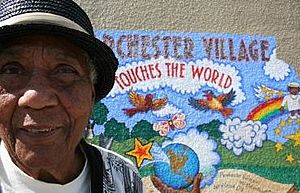Parchester Village, Richmond, California facts for kids
Parchester Village is a special community in Richmond, California. It was one of the first places in California where African-American families could buy homes. It was planned carefully to be a great place to live.
Contents
The Story of Parchester Village
Building a New Community
After World War II, many temporary homes in Richmond were taken down. Sadly, many black residents were not allowed to move into other available housing. Reverend Guthrie John Williams worked hard to change this. In 1949, he made a deal to get more homes for black families.
Reverend Williams met Fred Parr, a rich real estate developer. Mr. Parr helped to build about 400 single-story homes. Parchester Village was first planned to be for "All Americans". This meant people of all races could live there. However, it became an all-black neighborhood. This happened because white people lost interest in buying homes there once they knew it would be racially mixed.
Naming the Streets
Many streets in Parchester Village are named after important black pastors from that time. Williams Street, for example, is one of the main roads in the community. The name "Parchester" comes from Fred Parr. He was the Richmond businessman who helped fund and create this new community.
Growing and Changing
Today, Parchester Village is mostly African-American. However, more and more Latino, Asian, and White families are moving in. The community has welcomed these new neighbors.
For many years, people in Parchester Village could easily visit Dotson Family Marsh. This area was once called Breuner Marsh. They enjoyed swimming and fishing from its pier. Over time, it became harder to access the marsh. This was due to changes in the land and who owned it.
In the 1970s, the community worked together to stop an airfield from being built there. Later, some builders wanted to create fancy homes near the village. But residents wanted to keep the area as open space. The city also wanted a mix of park and small businesses. In the end, the land became part of Point Pinole Regional Shoreline. This happened in 2010.
Community Decisions
In the early 2000s, the Scotts Valley Band of Pomo Indians suggested building a large casino nearby. It was called the Sugar Bowl Casino. Many Parchester Village residents thought this was a good idea. They believed it would create jobs for people. However, people living in newer areas nearby did not want the casino. They worried it would lower their property values. Even so, the casino was approved to be built and opened.
Where is Parchester Village?
Getting Around
AC Transit bus lines 71 and 376 serve Parchester Village. These buses connect the neighborhood to downtown Richmond. They also go to the BART and Amtrak station. You can also reach Contra Costa College in San Pablo. The buses also connect to the Hilltop Area and the Richmond Parkway Transit Center. There are also several school bus routes. These buses connect the village to local middle and high schools.
Neighborhood Borders
Parchester Village has interesting borders. To the north, it is next to Point Pinole Regional Shoreline. The West Contra Costa County Detention Center is also to the north. To the east, you'll find Atlas Road, SPRR tracks, and the Richmond Country Club. The Richmond Parkway is to the southeast. South of the village are open grasslands. To the west, you'll see Breuner Marsh and San Pablo Bay.
The area has amazing views of the waterfront and the park. You can also see Marin County and the North Bay Mountains.


